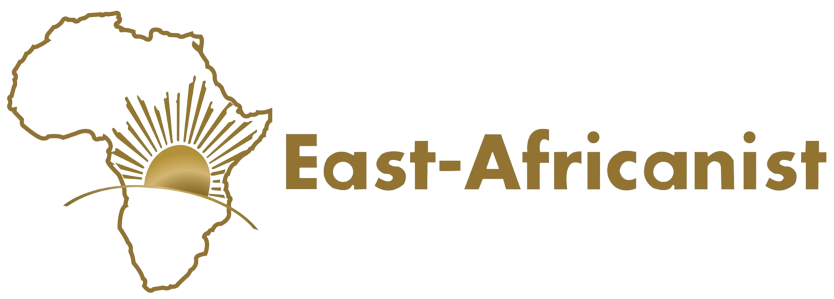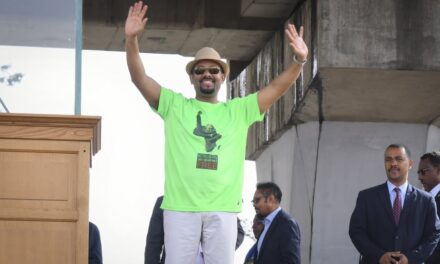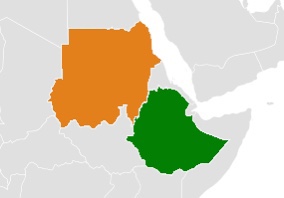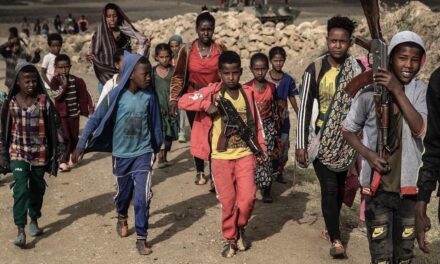Kristalina Georgieva, Managing Director of the International Monetary Fund, meeting with Abiy Ahmed, June 2023.
By: Biruk Haregu (PhD student in Public Policy and Political Economy, and a Pre-Doctoral Fellow at James Madison University in the U.S.)
On October 2, 2023, Abiy Ahmed shared with the Ethiopian public his regime’s approach to development economics and poverty reduction. He stated: “our belief is that we must see prosperity instead of poverty, happiness instead of problems, and peace instead of conflict. This requires a change in perspective and the power of our imagination.” In other words, poverty is a state-of-mind and something that can be overcome with a simple change in perspective both at the individual and country level. Not only is this rationale and approach to development economic policy inaccurate and misguided, but to suggest so is a dereliction of duty, particularly in a country where poverty is endemic and persistent.
According to the United Nations Development Programme (UNDP), in Ethiopia, 68.7% of the population is multidimensionally poor, while an additional 18.4% is classified as vulnerable to multidimensional poverty. Furthermore, while Abiy has been in power, poverty has rapidly increased across every region of Ethiopia and the major cities of Addis Ababa and Dire Dawa (Figure 1). Precipitating and exacerbating the increase in poverty is Abiy’s ceaseless armed conflicts throughout Northern Ethiopia.
At its core, economics is a social science that studies methods of allocating scarce resources among competing wants. And foundations of good economic policy rest on a strategic and evidence-based approach to economic policy formulation, implementation, and evaluation. Additionally, economic policy is an iterative process; and in the Ethiopian context, must facilitate structural economic transformational, socioeconomic development, and poverty reduction in accordance with Ethiopia’s dynamic comparative advantage— labor-intensive agro-processing, manufacturing, and industry. In short, development economics and poverty reduction are not the lackadaisical and haphazard process that Abiy suggests.
Figure 1: Simulation of Trends in Headcount Poverty (%)
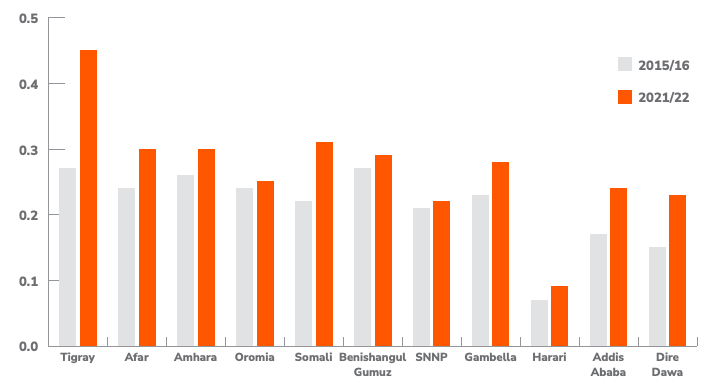
Source: UNDP-Ethiopia estimates
The contours of Abiynomics
During the past 5 years, Abiy’s approach to economic policy— Abiynomics— has demonstrably proven to be non-strategic, misaligned, confused, and socioeconomically ruinous. First, the principal strategic error is the abrupt shift in economic policy from the robust industrial parks policy that aimed to develop and strengthen manufacturing and industry in Ethiopia, to Abiy’s hodgepodge initiatives spanning cosmetic construction projects, agricultural initiatives, and mass privatization— all of which, coupled with Abiy’s devastating civil wars, have delivered lackluster results, while increasing poverty across Ethiopia.
Second, Abiy’s economic policy is not aligned with Ethiopia’s dynamic comparative advantage. The concept of comparative advantage asserts that countries are better off specializing in the production of goods that can be produced at the cheapest cost relative to other countries and engaging in international trade. In the Ethiopian context, that comparative advantage is labor-intensive manufacturing, including agro-processing, textiles, garments, and leather products, among others. This comparative advantage is derived from Ethiopia’s large population, low cost of labor, availability of inputs, robust domestic market, and the hitherto political and macroeconomic stability.
Third, Abiynomics has proven to be confused. Rather than addressing potential headwinds and challenges of the once promising industrial parks policy, Abiynomics has prioritized vanity white elephant projects; while at the same time, returning to agricultural-led industrialization— a policy that was attempted in the early 2000s and found to be inadequate for addressing Ethiopia’s needs of rapid employment creation, wage generation, and structural transformation.
Paradoxically, with a return to agricultural-led industrialization, Abiynomics claims two contradictory things: on the one hand, import-substitution to address food insecurity in Ethiopia, while on the other hand, export-led industrialization vis-à-vis exporting of “surplus” wheat to earn foreign exchange. The reality is that exorbitant inflation of agricultural commodities and widespread food insecurity is plaguing Ethiopians, as indicated by the 20.1 million Ethiopians in need of emergency food aid.
Graph 1: Inflation rates, and average consumer prices in Ethiopia and the world

Source: International Monetary Fund
Flash as Deception: Abiy’s vanity white elephant projects
Rather than directly addressing poverty, food insecurity or post-war reconstruction, Ethiopia’s increasingly limited resources are being allocated to construct Abiy’s white elephant projects. These projects include Abiy’s exorbitant $15 billion pharaonic palace, a $4 billion palace for the President of the Oromia region, and numerous resorts and lodges (Halala Kella, Gorgora, Wonchi, and Chebera Churchura). These are quintessential ‘white elephant’ projects— projects that are attention grabbing, extremely expensive, but have limited economic and societal benefit. For instance, during the Presidency of Kwame Nkrumah, Ghana was the poster child for white elephant projects that inevitably led to high levels of indebtedness, unproductivity, and the eventual removal of Nkrumah from office. Under Abiy, Ethiopia is following the same ill-advised and ill-fated economic pathway.
In Ethiopia, the focus on white elephant projects is completely misguided and indicative of a lack policy prioritization. In a country where per capital GDP is approximately $925, multidimensional poverty afflicts approximately 70% of the population, and $28 billion is needed for post-war reconstruction, allocating Ethiopia’s increasingly limited foreign exchange towards vanity projects is beyond misguided— it’s criminal. Ethiopia’s limited resources must be allocated towards improving the productivity of key economic sectors that will facilitate broad-based pro-poor economic growth, development, and structural economic transformation. Abiy’s vanity projects do not facilitate such a transformation.
Abiy’s fixation with such vanity projects raises critically important questions, such as: why is there no independent oversight? Who is receiving contracts for these construction projects? And in what ways do these projects, and its accompanying process, facilitate corruption and malfeasance? If the objective is advancing the public good and societal well-being, Abiy’s vanity white elephant projects will not achieve that objective.
A return to agricultural-led industrialization?
In addition to the policy of vanity white elephant projects, Abiynomics appears to have returned to the policy of agricultural-led industrialization, which was attempted in Ethiopia in the early 2000s. According to its proponents, agricultural-led industrialization would improve agricultural productivity and move the country toward commercial agricultural comprising of domestic and foreign investors; while at the same time, improving domestic food security and agricultural exports.
By 2010, it was clear that agricultural-led industrialization had failed in Ethiopia due to the fluctuation of commodity prices, overreliance on a volatile international market, and ultimately, the inability to improve agricultural productivity and food security for Ethiopians. Nevertheless, in 2023, the Abiy regime has inexplicably returned to agricultural-led industrialization.
In returning to agricultural-led industrialization, the policy is replete with obfuscation, grandiose statements, unaccounted for productivity claims, and inconsistencies. On the one hand, the Abiy regime states that its principal objective is import substitution to meet domestic demand, while on the other hand, the regime claims to have begun exporting “surplus wheat” while 20.1 million Ethiopians require emergency food aid and Ethiopia remains food insecure. Not only is the policy strategically inconsistent and misguided, but its implementation is confused, and its stated outcomes unclear, if not complete fabrications.
Furthermore, similar to Abiy’s vanity white elephant projects, the agricultural projects are mired in secrecy. There is no transparency regarding who receives contracts, how productivity is ensured, and what oversight mechanisms are in place to minimize corruption and malfeasance. In years past, the Ethiopian Agricultural Transformation Agency (ATA) had such a mandate. It’s unclear if Abiy’s regime has empowered ATA with such oversight responsibilities.
The state of manufacturing and industry in Ethiopia
Manufacturing continues to be Ethiopia’s comparative advantage. Consequently, in 2014/15, as a component of the developmental state, the Ethiopian industrial parks policy was revamped and launched to transform a poorly performing manufacturing sector, which contributed a meager 5% to GDP; while at the same time, aiming to transform an agrarian economy. In so doing, policymakers relied on economic liberalism, namely the theories of foreign direct investment and agglomeration, in the design and implementation of the industrial parks policy. The policy design effectively employed Ethiopia’s dynamic comparative advantage in labor-intensive and export-oriented manufacturing in the following key strategic industries:
- Agro-processing industry
- Meat, dairy, and honey processing industry
- Textile and garment industry
- Leather and leather products industry
- Metal engineering industry
- Chemical and construction inputs industry
- Pharmaceutical industry
More specifically, the industrial parks policy aimed to accomplish the following: 1) create employment opportunities; 2) improve productivity; 3) increase exports and foreign exchange earnings; 4) facilitate skills and technology transfers; and 5) create backward and forward industrial linkages. Since policy implementation, approximately 12 industrial parks have been constructed and operationalized.
During the initial years of the industrial parks program, manufacturing FDI inflow increased significantly (Table 1). For instance, in 2016, FDI inflow was $4.2 billion of which $3.7 billion was in the manufacturing sector. Such a robust increase in manufacturing FDI was a result of a strategically formulated and effectively implemented policy, reliable infrastructure including roads and railways, macroeconomic stability, regulatory certainty, tax and customs exemptions for investors, and streamlined licensing services via one-stop-shops. During this period, notable clothing manufacturers such Calvin Klein, Tommy Hilfiger, IZOD, and Van Heusen began investing in Ethiopia. Moreover, a World Bank study on Ethiopia’s industrial parks finds that the policy was broadly on the right path to attaining its objectives, notwithstanding some headwinds and course corrections that needed to be implemented.
Surprisingly, even though the industrial parks policy demonstrated great promise and delivered early successes, the Abiy regime has inexplicably pivoted away from the policy in favor of vanity white elephant projects and, to some extent, tourism in the midst of civil wars. As the World Bank warns, “it is vital that the government takes strong leadership of the [industrial parks] program and puts into place high-level strategic leadership and coordination mechanisms to ensure Ethiopia does not lose the gains made in the past few years and maximizes the returns from the significant public investments.” This begs the question: why would the Abiy regime ostensibly abandon a highly performing policy that is strategically aligned with Ethiopia’s comparative advantage in favor of vanity construction projects?
First, the shift in policy direction could be associated with Ethiopia no longer enjoying access to the U.S. market through the African Growth and Opportunities Act (AGOA). AGOA provided Ethiopia with duty free access to the U.S. market. Unfortunately, due to the 2-year civil war in Northern Ethiopia, and the ongoing civil war in the Amhara region, Ethiopia’s access to AGOA has been suspended. Notwithstanding this challenge, rather than abandon the promising industrial parks policy, the pragmatic approach is for the Abiy regime to cease its senseless chaos and military adventurism and look for peaceful means of attaining a durable political settlement. In doing so, regaining AGOA privileges. At the same time, it is incumbent on Ethiopian policymakers to diversify export markets for Ethiopian manufactured products. Abandoning or relegating the industrial parks policy to the back burner is a strategic blunder and unjustifiable.
Second, a critical reason for the relegation of the industrial parks policy may be that neither Abiy nor his inner circle have the requisite economic training to implement such an audacious economic agenda. In this regard, the World Bank finds that Ethiopia’s industrial parks require a “reinvigorated, consistent, and coordinated leadership from the highest levels of government, including the Prime Minister’s Office”— something that the World Bank finds is currently missing. Furthermore, the World Bank study states, “instituting previous practices at the highest level of government of regular, structured, discussions and meetings would help the government address investor concerns and challenges.” Comparatively, one of the critical elements of the acclaimed Asian Economic Miracle— which effectively utilized industrial parks for development— is the abundance of highly qualified subject matter experts and bureaucrats that oversaw the economic development process, both in evidence-based policy formulation and implementation.
Third, shifting the economic policy direction away from industrial parks and towards vanity white elephant projects enables Abiy to do two things: 1) to show flashy new constructions as a sign of faux progress and “prosperity”; and 2) the projects facilitate the mass misallocation and expropriation of resources without oversight. This is proving to be a major challenge for the industrial parks program. According to the World Bank, a major obstacle for the program has been the regime’s inability to “prioritize addressing existing infrastructure gaps (such as housing and utilities) and raising the quality and scope of one-stop-shop services in existing [industrial parks].” In other words, to maximize effectiveness and impact, it is imperative that available resource be allocated towards increasing capacities and infrastructure within industrial parks— something the Abiy regime is neglecting to do.
Abiy’s Prosperity or Poverty Party?
While the promising and successful industrial parks program remains neglected, Abiy’s political rhetoric has been of “prosperity.” However, socioeconomic data suggests exactly the opposite— Abiy’s Ethiopia is mired in poverty. For instance, according to a study conducted by UNDP, poverty is higher today than in 2016 and poverty is rapidly increasing across every region of Ethiopia. Similarly, a staggering 87% of Ethiopia’s population is either multidimensionally poor (68.7%) or vulnerable to multidimensional poverty (18.4%). Contributing to this pervasive poverty is consistently high unemployment and an inflation rate above 30% during the past 3 years. Additionally, per capital GDP remains stagnant at approximately $925, which places Ethiopia in the Least Developed Countries category (Figure 2) and makes the once vaunted goal of attaining middle-income status by 2025 increasingly challenging.
Furthermore, the most comprehensive measure of socioeconomic development is the Human Development Index (HDI), which captures human capital and societal well-being through the metrics of life expectancy, education attainment, and per capita GDP. Ethiopia’s HDI ranking is 175 out of 191, placing the country among the bottom tier of Least Developed Countries. Moreover, during Abiy’s tenure, Ethiopia’s HDI value has remained unchanged at an abysmal 0.498. This indicates a lack of effective evidence-based development policy formulation and implementation to improve the lives, livelihoods, and well-being of Ethiopians.
Figure 2: Ethiopia and Human Development Index (2021/22)

Source: United Nations Development Programme
Additionally, with the ceaseless chaos and conflict that Abiy is instigating throughout Ethiopia, consistency of foreign direct investment inflow has become a challenge. For example, foreign direct investment has been on a downward trajectory since Abiy came to power with the exception of 2021. For instance, the FDI inflow of $3.6 billion in 2022 is down from the peaks of $4.2 billion in 2016 and 2021. It must also be noted that the FDI inflows of $4.2 billion in 2021 and $3.6 billion in 2022 are an anomaly driven by the sale of shares of Ethio telecom to Safaricom. Comparatively, the FDI inflow of $4.2 billion in 2016 and 4 billion in 2017 was driven by investments in manufacturing. For example, $3.7 billion of the $4.2 billion in 2016 was FDI inflow to the manufacturing sector at the height of the industrial parks program.
Table 1: Total FDI Inflow into Ethiopia (2013-2022)
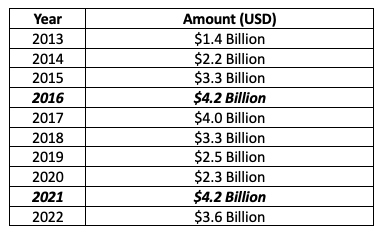
Source: United Nations Conference on Trade and Development
Finally, key social indicators all point to a deteriorating quality of life for Ethiopians. For instance: 1) 20.1 million citizens across Ethiopia need emergency food aid; 2) 5.4 of 6 million citizens in Tigray need emergency food aid; 3) 5.1 million Internally Displaced Persons, the highest level in the world, need humanitarian assistance; 4) $28 billion is needed for post-war reconstruction in Northern Ethiopia, including schools, clinics and hospitals; 5) 7.6 million children are out of school due to conflict; 6) 7% and 42% of the population has access to basic sanitation and clean drinking water, respectively; 7) long-lasting and widespread cholera outbreaks are afflicting citizens in 250 districts across 10 regions; and 8) poverty is rapidly rising across every region of Ethiopia. Additionally, the civil war in Northern Ethiopia has claimed an estimated 600,000 to 1 million lives, and Abiy has unconscionably opened yet another theater of conflict with his unjust war of aggression against the Amhara. All this social misery, in addition to the exorbitant inflation and unbearable cost of living.
In sum, socioeconomic data ranging from multidimensional poverty, human development index, human capital, per capital GDP, inflation, unemployment, and humanitarian assistance all point to the fact that Abiy’s claim of “prosperity” is unfounded political rhetoric. In fact, Abiy has mired Ethiopia in conflict and poverty.
Biruk Haregu (PhD student in Public Policy and Political Economy, and a Pre-Doctoral Fellow at James Madison University in the U.S.)
